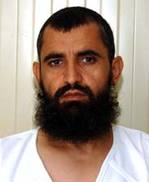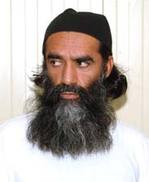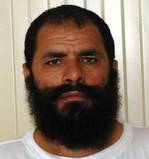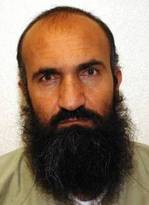The Obama administration is considering repatriating some Guantanamo detainees to Afghanistan as part of a diplomatic effort to engage the Taliban, according to Reuters.
Past attempts at such talks have been futile, Reuters notes, with the Americans engaging phony emissaries or Taliban officials with little to no real power. Earlier this year, Burhanuddin Rabbani, who led the Afghan High Peace Council, was assassinated by a suicide bomber claiming to represent Mullah Omar's Quetta Shura Taliban. That same council has repeatedly tried to broker the talks and sought to free Guantanamo detainees in the process.
"It is not known which [Guantanamo detainees] might be transferred," Reuters reports, "nor what assurances the White House has that the Karzai government would keep them in its custody."
The Afghan High Peace Council has previously lobbied for the release of the four top Taliban commanders held at Guantanamo. The Long War Journal has profiled these commanders earlier this year. [See LWJ report, Afghan peace council reportedly seeks talks with Taliban commanders held at Gitmo.]
The four Taliban leaders are: Abdul Haq Wasiq (former Taliban deputy minister of intelligence), Mullah Norullah Noori (a former Taliban governor and military commander), Mullah Mohammed Fazl (the Taliban army's chief of staff), and Mullah Khairullah Khairkhwa (the former Taliban governor of Herat province).
It is not known if the Obama administration is considering transferring any of the four. But it is difficult to see how any of the four could play a meaningful role in peace talks.
Since The Long War Journal last profiled these four Taliban detainees, relying on declassified Guantanamo documents and State Department cables, new documents have become available. Namely, leaked Joint Task Force Guantanamo (JTF-GTMO) memos outline the available intelligence on each of them.
All four were deemed "high" risks by US military intelligence officials, according to leaked JTF-GTMO memos. In addition, JTF-GTMO recommended that all four remain in the Defense Department's custody, as opposed to being transferred to the Afghan government. Approximately 200 other Afghans have been repatriated from Guantanamo. Two of the four Taliban commanders are wanted by the UN for war crimes.
All four had extensive ties to al Qaeda prior to their capture. Forswearing al Qaeda's terrorism is a key goal of the peace talks.
Abdul Haq Wasiq (Internment Serial Number 4)
Image may be NSFW.
Clik here to view.
Abdul Haq Wasiq, the former Taliban intelligence official, "had direct access to Taliban and Hezb-e-Islami Gulbuddin (HIG) leadership," according to a JTF-GTMO threat assessment. Wasiq "was central to the Taliban's efforts to form alliances with other Islamic fundamentalist groups to fight alongside the Taliban against U.S. and Coalition forces after the 11 September 2001 attacks."
JTF-GTMO concluded that Wasiq "utilized his office to support al Qaeda and to assist Taliban personnel elude capture" in late 2001. Wasiq also "arranged for al Qaeda personnel to train Taliban intelligence staff in intelligence methods."
Al Qaeda's training of Taliban operatives, arranged by Wasiq, was reportedly conducted by Hamza Zubayr, a terrorist who was formerly an instructor at one of al Qaeda's most important training camps. Zubayr was killed during the same September 2002 raid that netted 9/11 facilitator Ramzi Binalshibh. The assistance from Zubayr was crucially important to the Taliban's intelligence efforts, according to the JTF-GTMO file, because many of the administrators in the Taliban Ministry of Intelligence "had no prior intelligence background."
Mullah Norullah Noori (ISN 6)
Image may be NSFW.
Clik here to view.
Another leaked JTF-GTMO summarizes the intelligence on Mullah Norullah Noori. JTF-GTMO describes Noori as a "senior Taliban military commander" who was engaged in hostilities "against U.S. and Coalition forces in late 2001." Noori is "wanted by the United Nations (UN) for possible war crimes including the murder of thousands of Shiite Muslims."
When the JTF-GTMO threat assessment for Noori was authored in February 2008, his brother was still active in the fight against the Coalition. Noori's "brother is a Taliban commander directing operations against U.S. and Coalition forces in Zabul Province." Noori himself "remained a significant figure to Taliban supporters" even after his capture.
In addition to his ties to Mullah Omar and other senior Taliban leaders, Noori was "associated with...senior al Qaeda members and other extremist organizations."
Declassified memos authored at Guantanamo provide more details about Noori's al Qaeda ties. Noori "fought alongside al Qaeda as a Taliban military general, against the Northern Alliance" in September 1995. Noori also "hosted al Qaeda commanders" and "met a subordinate of Osama bin Laden to pass a message from the Taliban supreme leader" - that is, a message from Mullah Omar.
Mullah Mohammad Fazl, Taliban army chief of staff (ISN #7)
Image may be NSFW.
Clik here to view.
Mullah Mohammad Fazl was one of the Taliban's most experienced commanders prior to his capture in November 2001. Like Noori, according to another leaked JTF-GTMO file, Fazl is "wanted by the UN for possible war crimes including the murder of thousands of Shiites." Fazl "was associated with terrorist groups currently opposing U.S. and Coalition forces including al Qaeda, Islamic Movement of Uzbekistan (IMU), Hezb-e-Islami Gulbuddin (HIG), and an Anti-Coalition Militia group known as Harakat-i-Inqilab-i-Islami."
Fazl had "operational associations with significant al Qaeda and other extremist personnel," according to JTF-GTMO. One of the high-ranking al Qaeda commanders Fazl long cooperated with was Abdel Hadi al Iraqi, who led Osama bin Laden's Arab 055 Brigade in the Taliban's Afghanistan. The 055 Brigade was bin Laden's chief fighting force and served alongside Taliban units.
Immediately "following the assassination of Northern Alliance commander Ahmad Shah Massoud in September 2001," al Iraqi explained to US officials, "the Northern Alliance was demoralized" and the al Qaeda leader met with Fazl to "coordinate an attack with the Taliban against the Northern Alliance."
Prior to his detention, Fazl "wielded considerable influence throughout the northern region of Afghanistan and his influence continued after his capture." Fazl's "name and capture have been used in recruiting campaigns by the Taliban."
"If released," JTF-GTMO warned in the February 2008 memo, Fazl "would likely rejoin the Taliban and establish ties with [Anti-Coalition Militia] elements participating in hostilities against U.S. and Coalition forces in Afghanistan."
Mullah Khairullah Khairkhwa, former governor of Herat province (ISN 579)
Image may be NSFW.
Clik here to view.
Khairkhwa was one of Mullah Omar's closest confidantes prior to his capture. According to a JTF-GTMO file, Khairkhwa "was directly associated" with both Osama bin Laden and Mullah Omar. "Following the 11 September 2001 terrorist attacks," the leaked JTF-GTMO file reads, Khairkhwa "represented the Taliban during meetings with Iranian officials seeking to support hostilities against U.S. and Coalition Forces." In June, a DC district court denied Khairkhwa's petition for a writ of habeas corpus, based in large part on his admitted role in brokering the Taliban's post-9/11 deal with the Iranians. [See LWJ report, DC district court denies former Taliban governor's habeas petition.]
As the governor of Afghanistan's western Herat province, Khairkhwa and "his deputy were probably associated with a militant training camp in Herat operated by deceased al Qaeda commander (in Iraq) Abu Musab al Zarqawi."
In declassified memos prepared at Guantanamo, US officials alleged that Khairkhwa became a major drug trafficker as well. Khairkhwa reportedly built three walled compounds that he used to manage his opium trade. And he allegedly oversaw one of Osama bin Laden's training facilities in Herat, too. One US government memo notes that only Khairkhwa or bin Laden himself "could authorize entrance" to the facility, which was one of bin Laden's "most important bases" and "conducted terrorist training two times per week."
Catch and release in Afghanistan
A leaked State Department cable underscores the difficulties that both the Bush and Obama administrations have had in transferring war on terror detainees to Afghan custody. The cable, which originated at the US Embassy in Kabul on Aug. 6, 2009, notes that on "numerous occasions" American officials "have emphasized with Attorney General Aloko the need to end interventions by him and President Karzai, who both authorize the release of detainees pre-trial and allow dangerous individuals to go free or re-enter the battlefield without ever facing an Afghan court."
The cable makes it clear that this is a problem with respect to several categories of detainees: those transferred from the American-run facility in Bagram to Afghan custody; those transferred from Guantanamo to Afghan custody; and narco-traffickers. When the Afghan government accepts transferred detainees, it is supposed to take certain security precautions. In some cases, the US government expects the Afghans to try them in their courts. It often doesn't work out that way, however.
The leaked State Department cable cites dozens of pre-trial releases that the US government found problematic.
Top Taliban commanders, such as Mullah Zakir, have been released from Afghan custody after being transferred from Guantanamo. Zakir is the Quetta Shura Taliban's top military commander.
There is no reason to think that the situation would be different with any of the four Taliban commanders discussed above. If they are among the Guantanamo detainees the Obama administration is considering repatriating, then the Taliban may very well replenish its leadership ranks as part of this "peace" effort.